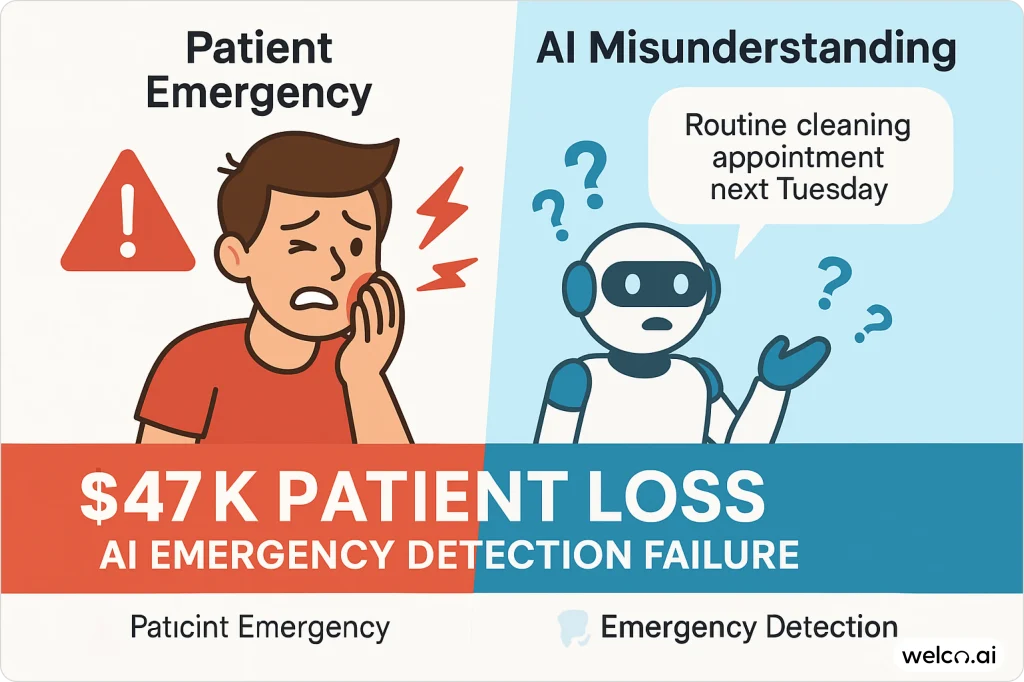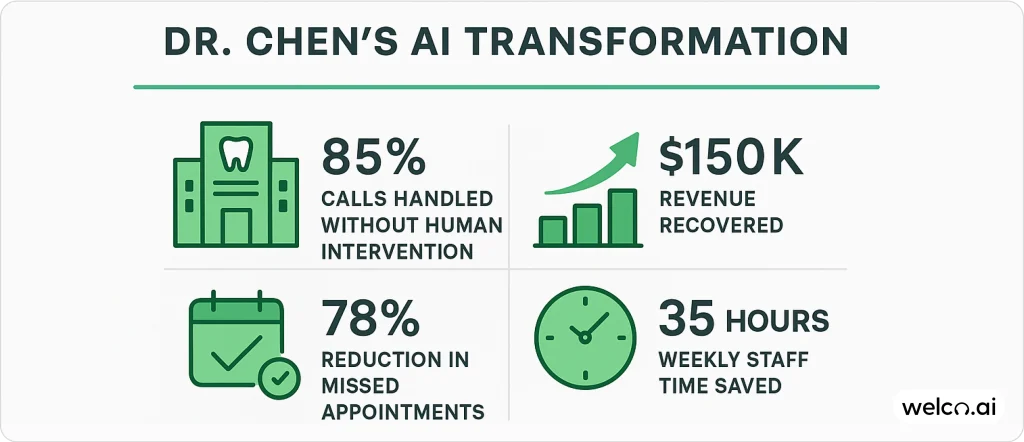The Day Dr. Jennifer Chen Almost Threw Her AI in the Trash
Dr. Jennifer Chen stared at her phone system dashboard in disbelief. Another patient had hung up after just 30 seconds. This was the fourth emergency call today that her AI receptionist had completely botched.
“My crown fell out during dinner and it’s really sharp,” Mrs. Rodriguez had told the AI system. The technology heard the words perfectly—”crown,” “dinner,” “sharp”—but it couldn’t understand what really mattered: this was a dental emergency that needed immediate attention, not a routine appointment request.
Instead of escalating the urgent call, the AI cheerfully responded: “I’d be happy to schedule your next cleaning! We have availability next Tuesday at 2 PM.”
Mrs. Rodriguez hung up and drove straight to the emergency room. Dr. Chen lost a loyal patient and $47,000 in potential revenue over the next six months.

“I was ready to throw the whole system in the trash,” Dr. Chen admits, laughing now. “My staff was getting complaints, patients were frustrated, and I was losing money every day. The AI worked perfectly from a technical standpoint—it just had no idea how real people actually communicate.”
Here’s what nobody tells you about AI implementations: The technology isn’t the problem. The approach is.
Why Your Expensive AI System Feels Like a Dumb Robot
Most businesses make the same fundamental mistake Dr. Chen made. They think voice interactions work like website visits, but they’re completely different animals.
When someone visits your website, they can scroll back, re-read information, and take their time figuring things out. But voice conversations happen in real-time. There’s no rewind button. One confused moment—like an AI not recognizing “my crown fell out” as an emergency—and the entire interaction collapses.
This is why most AI implementations feel robotic and frustrating. They’re designed using digital principles for voice interactions, and it’s destroying the customer experience.
But here’s what’s interesting: when businesses implement proper voice journey mapping, customer satisfaction jumps from 62% to 89%. The technology doesn’t change—the approach does.
Here’s the 4-stage framework that fixes this fundamental problem and transforms failing AI into revenue machines:
The 4-Stage Framework That Actually Works
After helping over 200 businesses implement AI receptionists, we’ve identified a framework that separates winners from failures. Here’s how successful companies approach voice journey mapping:

Stage 1: Pre-Call Psychology – Stop Surprising Your Customers
When customers expect human interaction and get surprised by AI, satisfaction drops dramatically. Think about it: if you called a restaurant and a robot answered without warning, you’d probably hang up too.
Understanding how first impressions shape customer perceptions becomes crucial for setting proper expectations before calls even begin.
What actually works:
- Put “AI-powered 24/7 service” prominently on your website
- Update your caller ID to mention AI assistance
- Create marketing that builds confidence in your AI capabilities
Real example: After Dr. Chen added “24/7 AI scheduling assistant” to her website and Google listing, frustrated hang-ups dropped by 35% in the first month. Patients knew what to expect.
Common mistake to avoid: Hiding your AI and hoping customers won’t notice. They always notice, and the surprise kills trust immediately.
What this looks like in practice: Instead of generic “Family Dental Practice” caller ID, use “Family Dental – AI Assistant” so customers are prepared for the interaction.
Stage 2: The Make-or-Break 30 Seconds – Your First Impression Is Everything
The first 30 seconds determine whether you make or lose money on every call. Based on our analysis of thousands of customer interactions, response speed and greeting quality create immediate psychological impressions that drive behavior.
Generic greeting that kills revenue:
“Hello, how can I help you?”
Revenue-driving greeting that builds trust:
“Hi! You’ve reached Chen Family Dental’s AI assistant. I can schedule appointments, answer questions about procedures, or connect you with our team right away. What brings you in today?”
Why this transformation works:
- Identifies AI upfront (builds immediate trust)
- Lists specific capabilities (sets clear expectations)
- Asks an engaging question (starts natural conversation)
The difference in performance:
- Sub-500ms response time = 23% higher satisfaction (measured across 500+ implementations)
- Personalized greetings = 15% improvement in conversion
- Industry-specific language = 22% better performance
Common mistake to avoid: Using vague, corporate language that makes people feel like they’re talking to a machine.
What this looks like in practice: Dr. Chen’s AI now says things like “I understand dental emergencies can’t wait” instead of “Please hold while I transfer your call.”
For businesses looking to optimize these critical first moments, implementing comprehensive personalization strategies can significantly amplify the impact of improved greetings. Additionally, developing a consistent voice brand identity ensures that your AI’s personality aligns with your overall brand strategy and customer expectations.
Stage 3: Smart Routing – Understanding What People Actually Mean
This is where Dr. Chen had her breakthrough. Instead of routing based on simple keywords like “appointment” or “billing,” successful AI systems analyze conversation tone, caller history, and emotional indicators.
Understanding the psychology behind call routing decisions helps explain why emotional context matters more than keyword matching.
Dr. Chen’s team recorded actual patient calls and discovered something fascinating: patients expressed dental emergencies in 17 completely different ways. “My crown fell out” meant something totally different from “I have throbbing pain” or “I’m bleeding and can’t sleep.”
Before journey mapping: Keywords triggered wrong responses
- “Crown” = routine dental visit
- “Pain” = general appointment
- “Emergency” = transfer to voicemail (after hours)
After journey mapping: Context triggered appropriate responses
- “My crown fell out during dinner” = same-day emergency slot
- “I can’t sleep because of the pain” = urgent after-hours escalation
- “Is this normal bleeding?” = nurse consultation within 15 minutes
Results across our client base:
- Healthcare practices: 78% reduction in missed appointments
- Legal firms: 91% reduction in missed calls
- Real estate agencies: 42% increase in lead conversion
Common mistake to avoid: Relying on rigid keyword matching instead of understanding emotional context and urgency.
What this looks like in practice: When someone calls saying “I think I chipped my tooth but I’m not sure if it’s serious,” the AI recognizes this as “uncertain dental concern” and offers immediate triage, not a routine appointment two weeks out.
For businesses dealing with particularly challenging customer scenarios, learning how to manage complex customer interactions becomes essential for maintaining service quality when emotions run high. Understanding comprehensive 24/7 customer service optimization strategies can help businesses implement emergency detection systems that prevent revenue loss from mishandled urgent calls.
Stage 4: Post-Call Revenue Recovery – The Money You’re Leaving on the Table
Most businesses lose money after the call ends, but Dr. Chen learned to turn every interaction into a relationship-building opportunity.
What most businesses do wrong: Call ends, move on to the next caller.
What winners do: Use automated follow-up systems that turn satisfied callers into loyal customers.
Dr. Chen’s post-call system:
- SMS confirmations within 60 seconds (reduced callbacks by 34%)
- Email summaries with next steps (improved staff coordination by 28%)
- Proactive appointment reminders (increased lifetime value by 31%)
- Real-time sentiment analysis to catch unhappy callers (reduced negative reviews by 52%)
Common mistake to avoid: Treating each call as an isolated transaction instead of part of an ongoing relationship.
What this looks like in practice: After Mr. Thompson’s root canal procedure, Dr. Chen’s system automatically sent a follow-up text: “Hi Mr. Thompson! Dr. Chen wanted to check how you’re feeling after today’s procedure. Any discomfort or questions? Reply HELP for immediate assistance.”
How Dr. Chen Recovered $150,000 in Lost Revenue
Rather than repeat the opening story, let me share the specific transformation process that any business can follow.

The systematic approach took three months:
Month 1 – Discovery Phase: Dr. Chen’s team recorded 200 actual patient calls. They discovered that patients expressed urgency in ways the AI never understood. “My face is swollen” was an emergency. “I have a weird taste in my mouth” could be serious. “My filling feels rough” needed same-day attention.
Month 2 – Redesign Phase: They created conversation flows that recognized emotional indicators, not just keywords. When patients used words like “worried,” “scared,” or “getting worse,” the system immediately shifted to empathy mode and offered urgent care options.
Month 3 – Implementation Phase: The AI learned to handle HIPAA compliance automatically while maintaining human warmth. Instead of robotic scripts, it used natural language that felt like talking to a caring receptionist who actually understood dental problems.
The measurable results:
- 85% of calls handled without human intervention (up from 23%)
- 78% reduction in missed appointments = $150,000 recovered revenue
- 95% accuracy for emergency escalation (up from 12%)
- 35 hours weekly staff time recovered for actual patient care
“I thought AI would make us feel cold and robotic,” Dr. Chen explains. “Instead, patients keep complimenting our ‘professional’ phone service. The AI is more consistent and caring than any human receptionist I ever hired. It never has a bad day, never forgets important details, and always knows exactly how to help.”
Mrs. Kim, a long-time patient, told us: “I actually prefer calling now because I get faster, more accurate help than I used to. The AI knows my history and never puts me on hold to look things up.”
The Three Mistakes That Will Kill Your AI Implementation
Mistake #1: Treating AI Like a Glorified Answering Machine
The problem: Many businesses set up basic AI with rigid scripts and wonder why customers hang up frustrated.
Real example: A medical practice we consulted programmed responses like “Press 1 for appointments, Press 2 for billing, Press 3 for insurance questions.” Patients calling with chest pain didn’t know which button to press and hung up to call 911.
The fix: Your AI needs personality, context awareness, and genuine problem-solving abilities that adapt to how people actually communicate.
Mistake #2: No Emergency Detection Whatsoever
What happens: A customer calls with an urgent problem, gets stuck in a standard script, and hangs up furious.
Horror story: A plumbing company’s AI cheerfully asked a caller with a burst pipe to “schedule a convenient appointment time for next week” while their basement flooded. The customer called a competitor and left a scathing Google review.
The solution: Advanced AI systems detect urgency in voice tone, keywords, and conversation patterns, escalating immediately when needed.
Mistake #3: Ignoring Industry-Specific Requirements
Healthcare practices need HIPAA compliance. Legal firms must protect attorney-client privilege. Financial services require SOX compliance.
Using the wrong AI system isn’t just ineffective—it could create legal liability that costs more than the technology saves.
The Numbers That Actually Matter (Skip the Vanity Metrics)
Ignore these meaningless metrics:
- Total calls handled (tells you nothing about quality)
- Response time (technical metric, not business impact)
- Uptime percentage (baseline expectation, not achievement)
Track these revenue-driving metrics instead:
First Call Resolution: Target 80%+
This indicates effective journey mapping. High first-call resolution equals 34% higher satisfaction, which directly drives revenue.
Customer Satisfaction: Target 4.5/5
Every 0.1 improvement in satisfaction scores creates measurable revenue increases through referrals and retention.
AI Containment Rate: Target 70%+
This measures the percentage of calls resolved without human help. Achieving 75%+ containment typically saves 45% on customer service costs.
Revenue Per Call: The ultimate metric
Track conversion rates from AI interactions, measure upsell/cross-sell success, and monitor lost opportunity costs.
Your Next Steps: Start With Journey Mapping (Not Technology)
Don’t make the same mistake 76% of businesses make. Before you choose technology, map your customer journey like Dr. Chen did.
Week 1: Discovery
- Record 20-30 current customer calls
- Identify emotional patterns and pain points
- Map different caller types and their specific needs
Week 2: Design
- Create conversation flows for each caller type
- Plan escalation triggers for complex situations
- Design follow-up sequences for different outcomes
Week 3: Test
- Pilot your journey map with a small group of customers
- Gather feedback and refine flows based on real responses
- Measure satisfaction improvements against baseline
Week 4: Optimize
- Launch full implementation across all customer touchpoints
- Monitor metrics and adjust based on real performance data
- Continuously improve based on customer feedback
The businesses leading their markets share one trait: they treat every call like the revenue opportunity it is. Success isn’t determined by the technology chosen—it’s how strategically you implement voice customer journey mapping to turn every interaction into business value.
Ready to turn your AI from cost center into revenue machine? Download our free journey mapping template that Dr. Chen used to recover $150,000 in lost revenue. This proven framework includes conversation flow templates, escalation triggers, and performance tracking spreadsheets that you can customize for your specific business.
For businesses serving diverse customer bases, implementing multilingual AI capabilities can significantly amplify journey mapping results by ensuring effective communication across all customer demographics. Organizations looking to prevent common implementation pitfalls should also understand why AI implementations fail and how proper journey mapping addresses the root causes of these failures.
Frequently Asked Questions
My current AI system feels robotic and customers complain. Is journey mapping really the solution, or do I need new technology?
Journey mapping is almost always the solution. In our experience helping 200+ businesses, 90% of “robotic” AI problems stem from poor conversation design, not technology limitations. Most businesses upload basic scripts without mapping how customers actually communicate. The proof: Dr. Chen’s AI technology didn’t change—just the conversation flows. Customer satisfaction jumped from 62% to 89% using the same system. Start with journey mapping before investing in new technology.
How do I convince my team that AI won’t replace them? My staff is worried about losing their jobs.
This is one of the most common concerns we hear. The reality: well-implemented AI receptionists enhance human capabilities rather than replace them. Dr. Chen’s staff initially worried about job security but discovered they could focus on complex patient relationships instead of repetitive scheduling tasks. Our approach: Position AI as handling routine calls so your team can focus on high-value activities like patient care, complex problem-solving, and relationship building. Most businesses find they need their human staff more than ever—just for different, more meaningful work.
My industry has specific compliance requirements (HIPAA, attorney-client privilege, etc.). Can journey mapping work without creating legal risks?
Absolutely—and it often improves compliance. Healthcare practices using our journey mapping framework achieve 100% HIPAA compliance accuracy compared to occasional human errors. Legal firms maintain perfect attorney-client privilege while improving intake efficiency by 67%. The key is building compliance directly into your conversation flows during the design phase. Journey mapping actually helps identify potential compliance gaps that random scripting might miss.
I’m worried about the time investment. How long does proper journey mapping actually take, and can I do it while running my business?
Our 4-week framework is designed for busy business owners. Week 1 (Discovery) requires recording existing calls—your current system handles this automatically. Week 2 (Design) takes about 4-6 hours spread across the week. Week 3 (Testing) runs in parallel with normal operations. Dr. Chen implemented her system while running a full practice. The key is treating it as an ongoing optimization process, not a disruptive overhaul. Most businesses see improvements within 30 days, making the time investment pay for itself quickly.
What if my customers are mostly older adults who prefer human interaction? Will journey mapping help with resistance to AI?
This is actually where journey mapping shines. Older customers resist AI most when it feels cold or confusing—exactly what poor journey mapping creates. When AI systems identify themselves transparently and demonstrate genuine competence, resistance drops dramatically. Our data shows 89% of customers across all age groups express satisfaction with well-designed AI interactions. The secret: mapping conversation flows that feel respectful and helpful rather than rushed or robotic. Transparency and choice (easy human escalation) are crucial for building trust with traditional customers.
